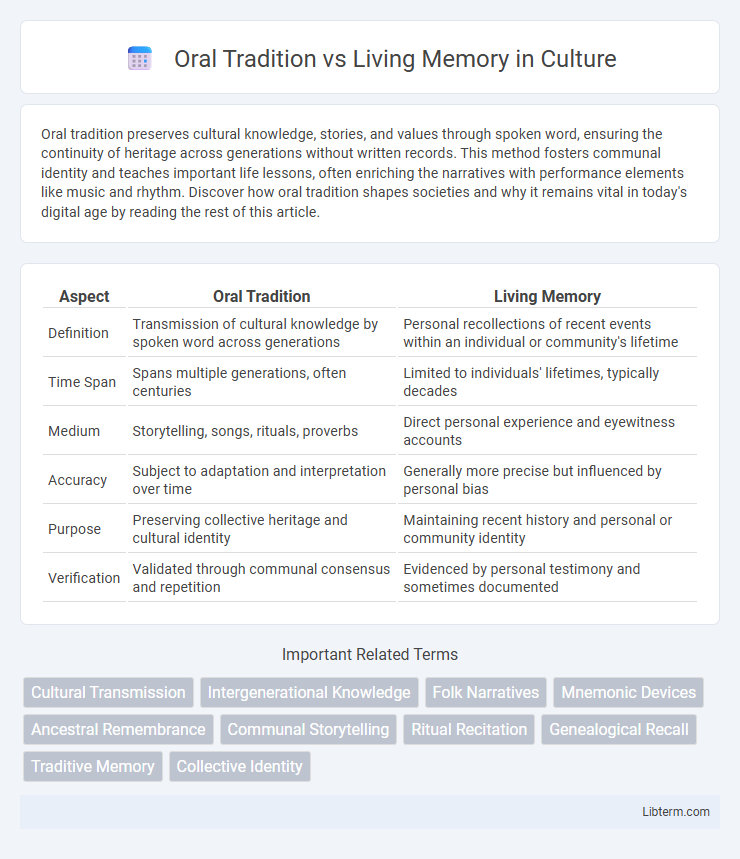Oral tradition preserves cultural knowledge, stories, and values through spoken word, ensuring the continuity of heritage across generations without written records. This method fosters communal identity and teaches important life lessons, often enriching the narratives with performance elements like music and rhythm. Discover how oral tradition shapes societies and why it remains vital in today's digital age by reading the rest of this article.
Table of Comparison
| Aspect | Oral Tradition | Living Memory |
|---|---|---|
| Definition | Transmission of cultural knowledge by spoken word across generations | Personal recollections of recent events within an individual or community's lifetime |
| Time Span | Spans multiple generations, often centuries | Limited to individuals' lifetimes, typically decades |
| Medium | Storytelling, songs, rituals, proverbs | Direct personal experience and eyewitness accounts |
| Accuracy | Subject to adaptation and interpretation over time | Generally more precise but influenced by personal bias |
| Purpose | Preserving collective heritage and cultural identity | Maintaining recent history and personal or community identity |
| Verification | Validated through communal consensus and repetition | Evidenced by personal testimony and sometimes documented |
Defining Oral Tradition and Living Memory
Oral tradition refers to the collective transmission of cultural knowledge, beliefs, and history through spoken word across multiple generations, preserving community identity over centuries. Living memory involves firsthand or communal recollection of events experienced within a single generation, often shaping immediate social and cultural understanding. Both serve as critical frameworks for cultural continuity, with oral tradition emphasizing long-term preservation and living memory focusing on recent, personal experience.
Historical Contexts of Oral Tradition
Oral tradition serves as a crucial method for preserving historical contexts in societies lacking written records, transmitting cultural knowledge, beliefs, and events across generations through storytelling, songs, and rituals. Living memory complements oral tradition by providing immediate, firsthand accounts that anchor narratives within current communal experiences, enhancing the continuity and authenticity of historical transmission. Together, they form dynamic systems that sustain collective memory, shaping identity and social cohesion within diverse cultural landscapes.
The Role of Living Memory in Cultural Preservation
Living memory serves as a dynamic repository of cultural identity, enabling communities to transmit values, histories, and practices through direct experience and personal recollection. Unlike oral tradition, which often relies on formalized storytelling methods, living memory evolves with each generation, fostering a continuous and adaptive cultural preservation process. This immediacy in recalling and sharing lived experiences strengthens communal bonds and ensures that cultural knowledge remains relevant and vibrant across time.
Transmission Methods: Speech vs. Recollection
Oral tradition relies on speech as the primary transmission method, where stories, knowledge, and cultural values are conveyed verbally across generations, preserving historical continuity through performative narration. Living memory depends on personal recollection, encompassing individuals' direct experiences and memories that shape collective understanding of recent events, often subject to subjective interpretation. The distinction lies in oral tradition's structured, communal storytelling versus living memory's dynamic, individual-based recall.
Reliability and Accuracy: Comparing Both Approaches
Oral tradition preserves historical and cultural knowledge through generations but often introduces variations due to memory decay and interpretive changes. Living memory relies on firsthand experiences, providing higher reliability and accuracy for recent events while remaining subject to subjective bias and emotional influence. Comparing both approaches highlights that oral tradition offers valuable long-term cultural continuity, whereas living memory ensures precise and detailed recall of recent occurrences.
Community Engagement in Storytelling
Oral tradition relies on the collective participation of communities to preserve and transmit cultural narratives, fostering a shared identity through repeated storytelling events. Living memory involves real-time recollection from individuals within the community, capturing personal experiences that continually evolve and enrich communal history. Community engagement in storytelling strengthens social bonds, ensuring that both oral tradition and living memory remain dynamic and relevant across generations.
Challenges Facing Oral Traditions Today
Oral traditions face significant challenges today due to globalization, technological advancements, and the dominance of written and digital media, which threaten the transmission of cultural knowledge across generations. Rapid urbanization and language loss also contribute to the erosion of oral narratives, making it difficult for communities to maintain their living memory. Efforts to document and revitalize oral heritage through audio-visual recordings and community programs are crucial in preserving these intangible cultural assets.
The Impact of Modern Technology on Living Memory
Modern technology significantly enhances living memory by enabling real-time documentation and instant access to diverse experiences through digital platforms. Social media, video recordings, and cloud storage facilitate the preservation and dissemination of personal and communal histories, expanding the collective memory beyond oral tradition's limitations. This technological integration transforms living memory into a dynamic, easily shareable, and permanent resource, increasing its accuracy and reach across generations.
Intergenerational Knowledge Transfer
Oral tradition and living memory serve as crucial methods for intergenerational knowledge transfer, preserving cultural heritage and historical narratives through storytelling and collective memory. Oral traditions rely on structured narratives passed down over generations, often encompassing myths, legends, and rituals that shape community identity. Living memory emphasizes personal and communal experiences, fostering dynamic and adaptive transmission of knowledge within families and societies.
The Future of Oral Tradition and Living Memory
The future of oral tradition and living memory hinges on integrating digital technologies with cultural preservation methods to ensure the transmission of indigenous knowledge across generations. Advancements in audio-visual recording, virtual reality, and interactive storytelling platforms offer innovative pathways for safeguarding and revitalizing oral heritage. These tools empower communities to maintain living memory as a dynamic, evolving practice that adapts to contemporary contexts while honoring ancestral narratives.
Oral Tradition Infographic

 libterm.com
libterm.com